Jan Svoboda. Magnetic Techniques for the Treatment of Materials
Подождите немного. Документ загружается.

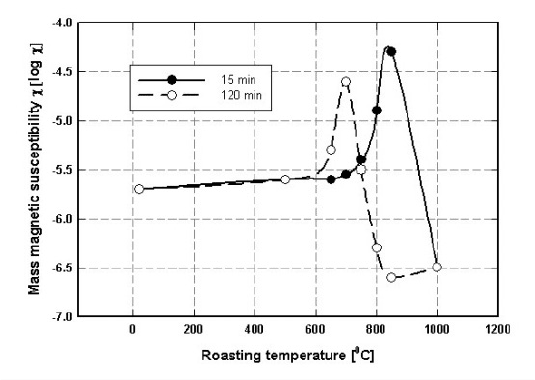
410 CHAPTER 5. PRACTICAL ASPECTS OF MAGNETIC METHODS
Figure 5.87: Oxidizing roasting of ilmenite: magnetic susceptibility of ilmenite
as a function of roasting time and temperature (adapted from
[C21]).
used routinely in the magnetic separation of mineral sands. For instance, il-
menite concentrates from heavy mineral deposits in northern Kwazulu-Natal
(South Africa) and Mozambique often contain as much as 0.3% Cr
2
O
3
,which
would contaminate the final high-titanium slag. While the magnetic suscepti-
bility of iron-poor chrome-rich spinel is similar to that ilmenite, it is not signif-
icantly aected by oxidizing roasting [N11]. However, six-fold increase in the
magnetic susceptibility of ilmenite, by oxidizing roasting, enabled the removal
of chromium-bearing spinel from ilmenite concentrates by magnetic separation
[N11]. This process is practiced at Richards Bay Minerals (South Africa) where
the ilmenite concentrate from WHIMS is roasted in a fluidized bed at a tem-
perature of 800
0
C for 40 minutes. The mass magnetic susceptibility increases
from 2.4×10
6
m
3
/kgto15×10
6
m
3
/kg.
A detailed laboratory investigation of the roasting behaviour of ilmenite
(St. Urbain, Quebec, Canada) was conducted by Ciu et al. [C21]. The test
results indicated that oxidizing roasting of ilmenite (" =2.18×10
6
m
3
/kg)
could increase its magnetic susceptibility within limited temperature and time
ranges. As is evident in Fig. 5.87, at 500
0
C, even extended heating (up to
2 hours) did not change the magnetic susceptibility of ilmenite. At higher
temperatures between 650
0
C and 700
0
C, the susceptibility started to increase
after about 30 minutes of roasting. After reaching its maximum at " = 5.5×10
5
m
3
/kg, the susceptibility dropped sharply to 4×10
7
m
3
/kg, lower than that of
the original ilmenite.
However, reduction roasting of ilmenite exhibited a considerably more sig-
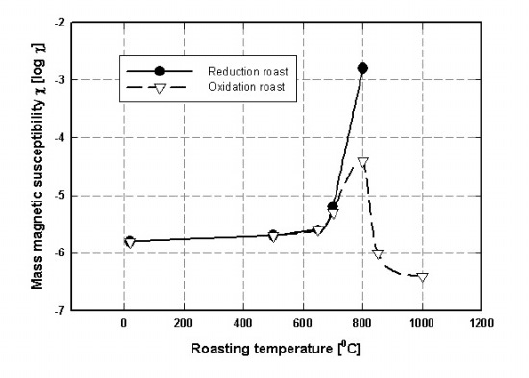
5.3. WET MAGNETIC SEPARATION 411
Figure 5.88: Magnetic susceptibility of ilmenite as a function of temperature, for
oxidizing and reduction roasting. Roast time: 30 min. (adapted
from [C21]).
nificant increase in magnetic susceptibility, approaching that of magnetite (" =
2×10
3
m
3
/kg), as is illustrated in Fig. 5.88.
Allen [A31, A32] conducted a thorough experimental study of the eect of
oxidizing roasting on the magnetic properties of ilmenite. He observed that
the ilmenite particles behaved as though they contained discrete ferromagnetic
components within a paramagnetic matrix. Magnetic changes at the roast tem-
perature up to 450
0
C were ascribed to small changes in size and shape of
small magnetic cells. Although magnetic susceptibility was found to increase
in the range around 500
0
C, the dierences were not su!ciently convincing.
At temperatures above 550
0
C, the growth of the magnetic cells and magnetic
susceptibility appeared to be time and temperature-dependent.
The de-coppering of galena and molybdenite concentrate by the removal of
chalcopyrite can be significantly improved by roasting the chalcopyrite. It was
reported by Makarow et al. [M30] that by heating chalcopyrite in an oxidizing
atmosphere to a temperature between 250
0
C and 500
0
C for 10 minutes, the
magnetic susceptibility of the product increased by three orders of magnitude.
5.3.10 The selectivity of separation
It was shown in Section 1.2 that a separation process will be selective only when
the magnitudes of the magnetic and competing forces are of comparable mag-
nitude, compatible with conditions expressed by eqs. (1.1). The relative values
of the magnetic and competing forces are thus critically important in determin-
412 CHAPTER 5. PRACTICAL ASPECTS OF MAGNETIC METHODS
ing the selectivity of magnetic separation. Because some of these forces have
dierent dependence on particle size, their relative importance will vary with
particle size, as has been outlined in Section 1.2.2. It is also important to recall,
as shown in Section 1.2.2, that particle size is a more important discriminating
factor in magnetic separation than magnetic susceptibility and that a magnetic
separator is also a particle size classifier.
Some investigators have tried to determine the threshold ratio of magnetic
susceptibilities of the components of a material mixture, for which their sep-
aration will be e!cient. Such a threshold ratio is generally of limited value
because of the significant eect of particle size distribution on the balance of
forces. Classification or desliming can alleviate the negative eects of wide size
distribution. In addition, magnetic susceptibilities of numerous materials de-
pend on the magnetic field strength, to which they are exposed, as discussed in
Section 1.4.7.
Of significant importance but particular di!culty is the selective separation
of fine materials. Large amounts of fines and ultrafines are generated during the
mining and milling of large tonnages of low-quality ores. A direct consequence
of this situation is an increasing need for e!cient technologies to beneficiate
the fines. It has been shown in Section 3.6 and in [S1] and [S31] that the
complexity of selective beneficiation of finely dispersed materials rests in the fact
that volumetric forces present in a separator, viz. magnetic, gravitational and
erosion forces, have to compete with surface forces. The question of whether a
quasi-colloidal particle will be captured by a matrix element covered by particles
previously deposited is thus determined, inter alia, by the surface characteristics
of the particles.
In practice, therefore, fine particles to be separated should be colloidally
unstable, i.e. they should not repel each other and thus prevent contact. On
the other hand, particles of the gangue minerals should not coagulate with those
of the valuable mineral lest they become entrained in the magnetic concentrate.
The eectofpHoftheslurry
An experimental study of the eect of pH on magnetic separation of weakly
magnetic iron ores [S38, S72] has shown that in order to achieve high recoveries
of iron and a high grade of the magnetic concentrate, the pH of the slurry must
be adjusted in such a way as to correspond to the point of zero charge (PZC) of
the oxide mineral. This behaviour was ascribed to a combination of ionic and
magnetic flocculation in the primary and secondary minima, and to a higher
retention probability of particles on the matrix [S72, S1].
Similar observations were made in the magnetic separation of uranium and
gold from cyanidation residues [S73]. As shown in Fig. 5.89, the grade of the
magnetic concentrate, as a function of pH, reaches its maximum at a pH of
1.2, and decreases continuously to the alkaline region. It can be seen that pH
adjustment from the usual operating value of about pH 9 can result in a gold
content increase by 25%.
Control of surface interactions can also result in selective coating of mineral
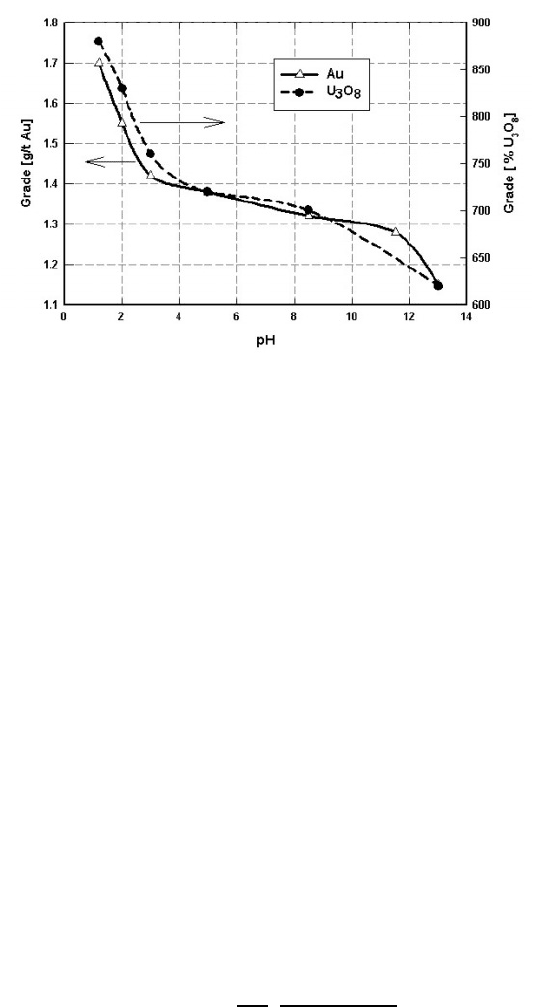
5.3. WET MAGNETIC SEPARATION 413
Figure 5.89: The grade of the magnetic concentrate from gold and uranium
cyanidation residues, as a function of pH (adapted from Svoboda
et al. [S73]).
and metallic particles with magnetite, followed by magnetic separation. It can
be used as a method of particle separation, as demonstrated, for example, by
Parsonage [P13].
Energeticandkineticcriteriaforselectiveseparation
In order to correlate quantitatively the rules for selective separation with the
results of experimental investigations, energetic and kinetic criteria, based on
DLVO theory, for selective magnetic separation of a useful mineral from a system
of containing several mineral species, were derived by Svoboda et al. [S76]. It
was shown that the onset of destabilization of a suspension and, consequently,
the critical condition for selective magnetic separation, is determined from the
energy condition Y
W
=0,whereY
W
is the total energy of interaction of two
particles and is given by eq. (3.123). At the same time, the residence time
w of particles in the magnetic field must be such that wAw
1@2
,wherew
1@2
is
the half time of coagulation, given by eq. (3.126). This condition imposes a
restriction on stability ratio Z , given by eq. (3.124), for a given concentration
of particles in a slurry. The stability ratio for a suspension containing l and m
mineral species can be re-written as:
Z
lm
=
4
Z
0
exp(
Y
lm
W
nW
)
e
l
+ e
m
(e
l
+ e
m
+ k)
2
gk (5.19)
where e
l
and e
m
are the radii of particles of species l and m, respectively, and k
is the distance between the surface of the interacting particles.
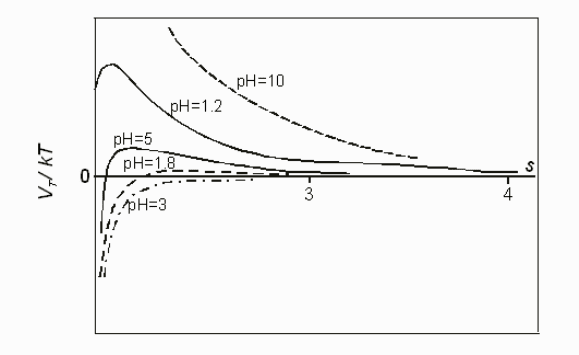
414 CHAPTER 5. PRACTICAL ASPECTS OF MAGNETIC METHODS
Figure 5.90: Total potential energy of interacting uraninite and quartz particles
(2e =5m), as a function of pH, at E
0
= 1 T (adapted from [S76]).
If a particle of a useful mineral is denoted by 1, and the gangue particle as
2, high recoveries will be achieved if Y
11
W
? 0andZ
11
? 1. Simultaneously, for
the grade of the magnetic concentrate to be high, one must ensure that valuable
and gangue particles do not coagulate mutually, and thus Y
12
W
A 0andZ
12
AA
1. Furthermore, to avoid the mechanical entrainment of large clusters of gangue
particles, it would be preferable to work under the condition Y
22
W
A 0andZ
22
A 1. These conditions for selective magnetic separation of fine particles can be
summarized as [S76]:
High recovery: Y
11
W
? 0; Z
11
? 1 (5.20)
High selectivity: Y
12
W
A 0; Z
12
AA 1andY
22
W
A 0; Z
22
A 1 (5.21)
The validity of these conditions was confirmed experimentally by magnetic
separation of uranium-gold cyanidation residues [S1, S73, S76]. The curves of
total potential energy of interaction of uraninite and quartz particles are shown
in Fig. 5.90. It can be seen that selective separation can be expected when Y
12
W
A 0, which occurs at pH 1.2. With further increase of pH, Y
12
W
decreases and
the selectivity is reduced. This trend is confirmed by the experimental results
shown in Fig. 5.89. Poor selectivity of separation in the alkaline region is a
consequence of heterocoagulation into a deep secondary minimum [S76].
Carrier magnetic separation
E!cient recovery of fine particles can be aided by promoting mutual interaction
between fine and coarse particles. In carrier (or piggy-back) magnetic sepa-
ration, coarse particles serve as carriers for fine particles. Carrier magnetic

5.3. WET MAGNETIC SEPARATION 415
Table 5.29: Magnetic separation of mixtures of dierent size fractions of
uranium-gold leach residues [S69].
Mixture Head Theoretical Experimental
5:1 [m] U
3
0
8
[ppm]
Grade
[ppm]
Recovery
[%]
U
3
O
8
Grade
[ppm]
Recovery
[%]
U
3
O
8
-17+(-53+25) 185 820 30 1033 52
-17+(-75+53) 173 700 29 850 40
-17+(-150+106) 159 616 27 600 22
separation makes use of the fact that the frequency of particle collisions is much
greater when there are particles of dierent sizes, which is the result of dierent
trajectories in the accelerating fluid. The rate of adhesion of fine particles (e
2 m) to coarse ones (e 30 m) is 10
3
to 10
4
times higher than the rate of
adhesion between fine particles [S77].
The results of the investigation of the possible eect of carrier magnetic
separation on the e!ciency of separation are summarized in Table 5.29 [S69].
It can be seen that the presence of fractions - 53 + 25 mand-75+53m
considerably enhanced the recovery of uranium from the fine (- 17 m) fraction,
and the grade of the magnetic fraction.
The presence of the coarse fraction (- 150 + 106 m) neither improved the
selectivity of the process nor increased the recovery of uranium from the fine
fraction. Moreover, no dependence of recovery or grade on pH was observed, in
contrast to the mixtures of finer fractions, where pH played an important role.
Since the value of pH did not aect the e!ciency of separation of individual size
fractions, it is obvious that pH influenced mutual interaction of fine and coarser
particles.
A detailed investigation of carrier magnetic separation was carried out by
Yanmin Wang et al. [W25] and the results confirmed the trends observed by
Svoboda [S69, S1]. A purified chromite concentrate and chromite ore slime were
used in that investigation. A very fine fraction (- 10 m) was mixed with coarse
fractions, - 53 + 38 m, - 75 + 53 m and - 106 + 75 m. It was found that the
fine particles coagulated onto the coarse ones and the cluster thus formed was
recovered in the matrix of a magnetic separator. The fraction - 53 + 38 mwas
found to be the most eective in improving the process e!ciency, as shown in
Fig. 5.91. The process of carrier separation was also found to be dependent on
pH and the highest e!ciency was achieved at a pH near the point-of-zero-charge
of the valuable mineral.
The matrix vibration and slurry pulsation
The vibration of a matrix, either by mechanical or electromagnetic means, was
proposed by several investigators, to assist in the flushing of the matrix, to
propel the ore through the matrix in dry high-gradient magnetic separation and
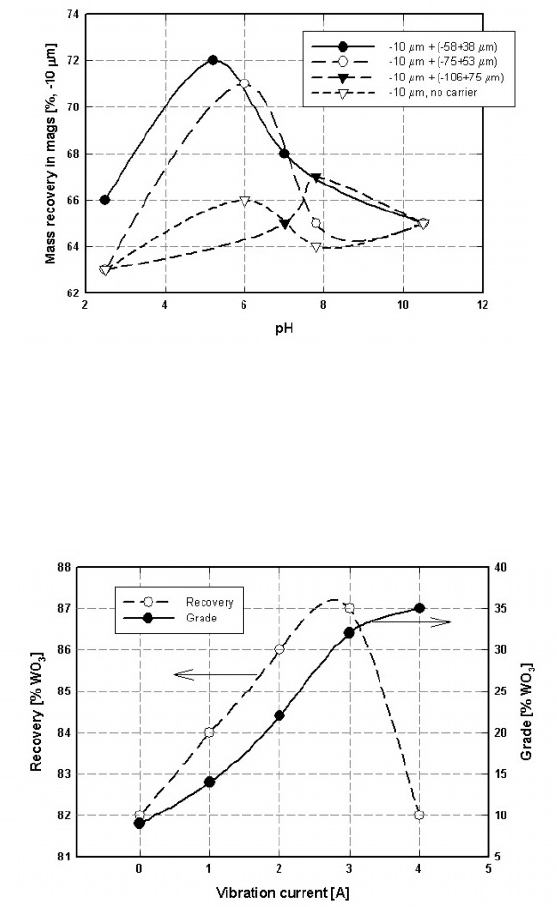
416 CHAPTER 5. PRACTICAL ASPECTS OF MAGNETIC METHODS
Figure 5.91: The eect of pH and carrier size on the mass recovery of chromite (-
10 m) by magnetic separation (adapted from Wang et al. [W25]).
Figure 5.92: Vibration-assisted magnetic separation of wolframite-quartz mix-
ture as a function of the vibration current (adapted from [S78]).
5.3. WET MAGNETIC SEPARATION 417
to improve the e!ciency of separation [K5, L14]. Mechanical vibration can be
provided, for instance, by an eccentric rotating shaft driven by a variable speed
motor. Longitudinal electromagnetic vibration is provided by a coil mounted
on the chamber and energized with alternating current. A vibratory force is
exerted on the coil by the interaction of the d.c. field generated by the magnet
of the separator, and of the a.c. field in the coil.
The vibration of the matrix reduces the mechanical entrainment of gangue
particles in the magnetic product and facilitates their desorption from the matrix
by fluid flow. For instance, matrix vibration was found to improve the selectivity
of wet high-gradient magnetic separation of wolframite-cassiterite slimes and of
wolframite-quartz mixtures, as is shown in Fig. 5.92 [S78], and of Cu-Pb and
Cu-Mo flotation concentrates [Y3]. The application of matrix vibration also
resulted in an increased recovery of kaolin in wet [L15] and dry [Y4] high-
gradient magnetic separation.
Pulsation of a slurry proved to be a useful approach to improving selectivity
of separation and reducing matrix blockage in HGMS. When applied to a low-
intensity drum magnetic separator, the slurry pulsation resulted in an improved
quality of the magnetic concentrate [K22]. Slurry pulsation, developed by Liu
Shuyi et al. [Y2] is being successfully used, on production scale, in SLON high-
gradient magnetic separators [X1].
5.3.11 Comparative tests with wet high-intensity magnetic
separators
As discussed in Chapter 2, the development and commercialization of high-
gradient magnetic separation as a viable technique for mineral beneficiation
resulted in the design and manufacture of a wide range of wet high-intensity
magnetic separators.
Most wet high-intensity magnetic separators dier in those technical and op-
erational characteristics that can significantly aect their performance and cost-
eectiveness. Any comparison of these separators should, therefore, take into
consideration, in addition to the feed properties and the product requirements,
the size of the operation and the capability of the machine to be scaled-up, if
necessary.
Magnetic separation equipment, and particularly WHIMS and HGMS ma-
chines, cannot be readily miniaturized for bench-scale testing. The bench-scale
testing is, therefore, often focused on characterization of the feed and of the
separation products, as a function of those variables that can be controlled in
pilot-scale testing. Without proper understanding of these characteristics it may
be impossible, except by luck, to end up with a successful process.
On the other hand, pilot-scale tests are usually carried out using commercial
equipment, at full feed rates and over an extended time scale. Reliable technical
and economic assessment of the operation can then be made.
Comparative pilot-scale tests of several wet matrix high-intensity magnetic
separators were described by Forssberg and Kostkevicius [F22]. Five models,
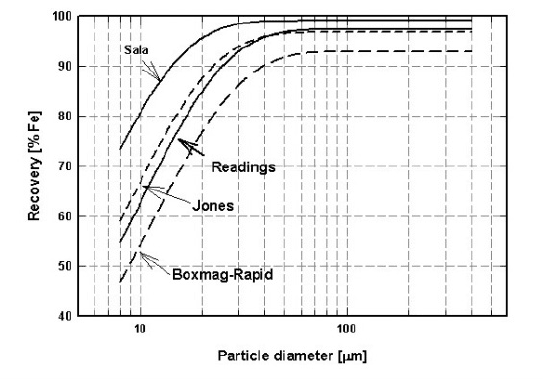
418 CHAPTER 5. PRACTICAL ASPECTS OF MAGNETIC METHODS
Figure 5.93: Recovery as a function of particle size for assorted wet matrix high-
intensity magnetic separators (adapted from [F22]).
representing three distinct principles of magnetic circuit design, with three dif-
ferent types of matrices were tested. A mixture of hematite and quartzite, with
97% of the particles being smaller than 300 m and 21% smaller than 15 m,
was used as a test material. The mean magnetic susceptibility of the mixture
was approximately 2.5×10
6
m
3
/kg.
The technical data of the separators used in the tests are summarized in Ta-
ble 5.30. The eect of particle size on iron recovery is given in Fig. 5.93. For fine
particles smaller than 50 m, the Sala HGMS was most e!cient, followed by the
Jones and Reading machines. The e!ciency on coarser material was comparable
among these separators, although the Jones separator showed a fall-o in the
recovery in coarse fractions associated with the middlings flushing. The energy
consumption was lowest in the Jones separator (0.5 kWh/t), followed by the
Reading and Boxmag-Rapid machines, although the value of this information is
limited as the rating is likely to change for large-scale machines. The optimum
metallurgical results obtained with these separators are shown in Table 5.31.
Although these results indicate the potential these various machines have,
their direct translation into large-scale applications must be done with caution.
Dierent separators have dierent potential for scale-up and the metallurgical
performance, consumption of energy and water, and resistance to matrix clog-
ging, will vary with the size of the machine. The assessment of the technological
and economic potential of each machine must be based on a detailed analysis
of their performance with a wide range of ores of dierent magnetic suscepti-
bilities and size distributions, taking into account the anticipated magnitude of
the operation.

5.3. WET MAGNETIC SEPARATION 419
Table 5.30: Specifications of magnetic separators used in tests [F22].
Parameter Jones
P71
Boxmag
SHW1
Reading
16 pole
Sala
HGMS
MkII
Matrix Grooved
plates
Triangular
bars
Salient
plates
Expanded
metal
Rotor dia. [mm] 710 800 1800 1720
Capacity [t/h] 1-2.5 1.5 - 6 15 - 30 1-3
No. of separation
zones
2 1 8 1
Matrix width [mm] 75 25 66 120
Matrix length [mm] 220 150 205 140
Mass [t] 7.1 3.8 7.1 6
Table 5.31: Representative metallurgical results obtained with dierent wet ma-
trix high-intensity magnetic separators [F22].
Separator Grade [% Fe] Recovery [% Fe]
Sala HGMS Mk II 66.0 94.0
Jones P71 66.0 92.0
Reading WHIMS-16 65.0 91.5
Boxmag-Rapid SHWI 64.5 85.5
